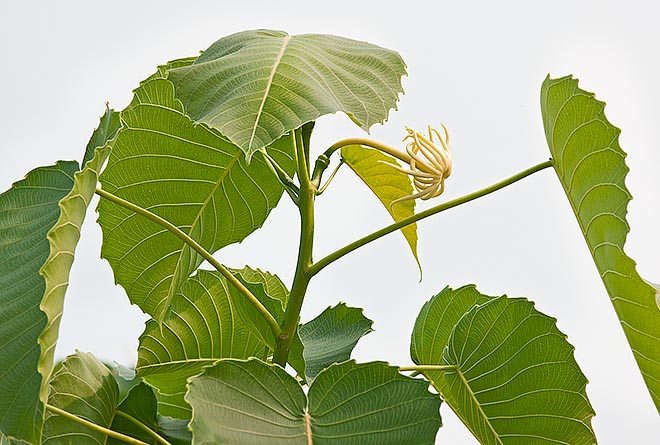Family : Euphorbiaceae

Text © Pietro Puccio

English translation by Mario Beltramini

Hura polyandra is a tree reaching 20 m of height. Close-up with a female flower © Giuseppe Mazza
The name of the genus is that given by the locals and means “poisonous lymph”.
The name of the species is the combination of the Greek terms “polys” = much and “anér, andros” = man, male, with reference to the numerous stamina.
Common names: sand box tree (English); árbol del diablo, habilla de San Ignacio, habillo, jabillo, jacobillo, ovillo, palo villa, pochocuape (Spanish).
The Hura polyandra Baill. (1858) is a semi-deciduous, up to about 20 m tall, with wide foliage, trunk of a diameter mainly going from 15 to 45 cm and greyish bark provided with robust conical thorns, 0,6-1 cm long.

The male flowers are grouped in a terminal catkin (amentum) © Mazza
Unisexual flowers present on the same plant, the male ones, without petals and sessile, are grouped in a terminal catkin (amentum), of 4-6 cm of length and a maximum of 1,2 cm of diameter, on an up to about 10 cm long peduncle, the female flowers are axillary, solitary, on a peduncle long up to 10cm, without petals with truncated calyx, 3-8 cm long column and stigmatic disk (circular structure originated by the concrescence of the stigmata), deeply subdivided into 15-19 conical, 2-6 cm long, appendices and with a diameter of 0,1-0,3 cm at the base.
The fruits are woody capsules flattened at both ends, of about 10 cm of diameter and of 5-6 cm of height, with 15-19 slightly prominent ribs, containing discoid seeds, of 2-3 cm of diameter and thick 0,6 cm, of dark brown colour, which, when ripe, are violently expelled even up to more than 10 m. Much diffused species in the origin zones, in some areas dominant species, it stands among the greatest trees of tropical America.
For the ornamental foliage and appearance, it is at time utilized as road tree in the tropical and subtropical climate zones, even if the toxicity of all its parts and the seeds thrown violently limit its wider use; seeds and latex are, in fact, highly toxic, even fatal, the fact nevertheless remains that in small amounts they are utilized in the traditional medicine, notwithstanding several instances of poisoning.
In some locations, the latex is used for stunning the river fishes and for easing their seizure.
The brown to pale yellow wood is regularly traded and exported and used in the fabrication of furniture, even if its manufacturing may cause problems to particularly sensitive subjects.
→ To appreciate the biodiversity within the family EUPHORBIACEAE please click here.
